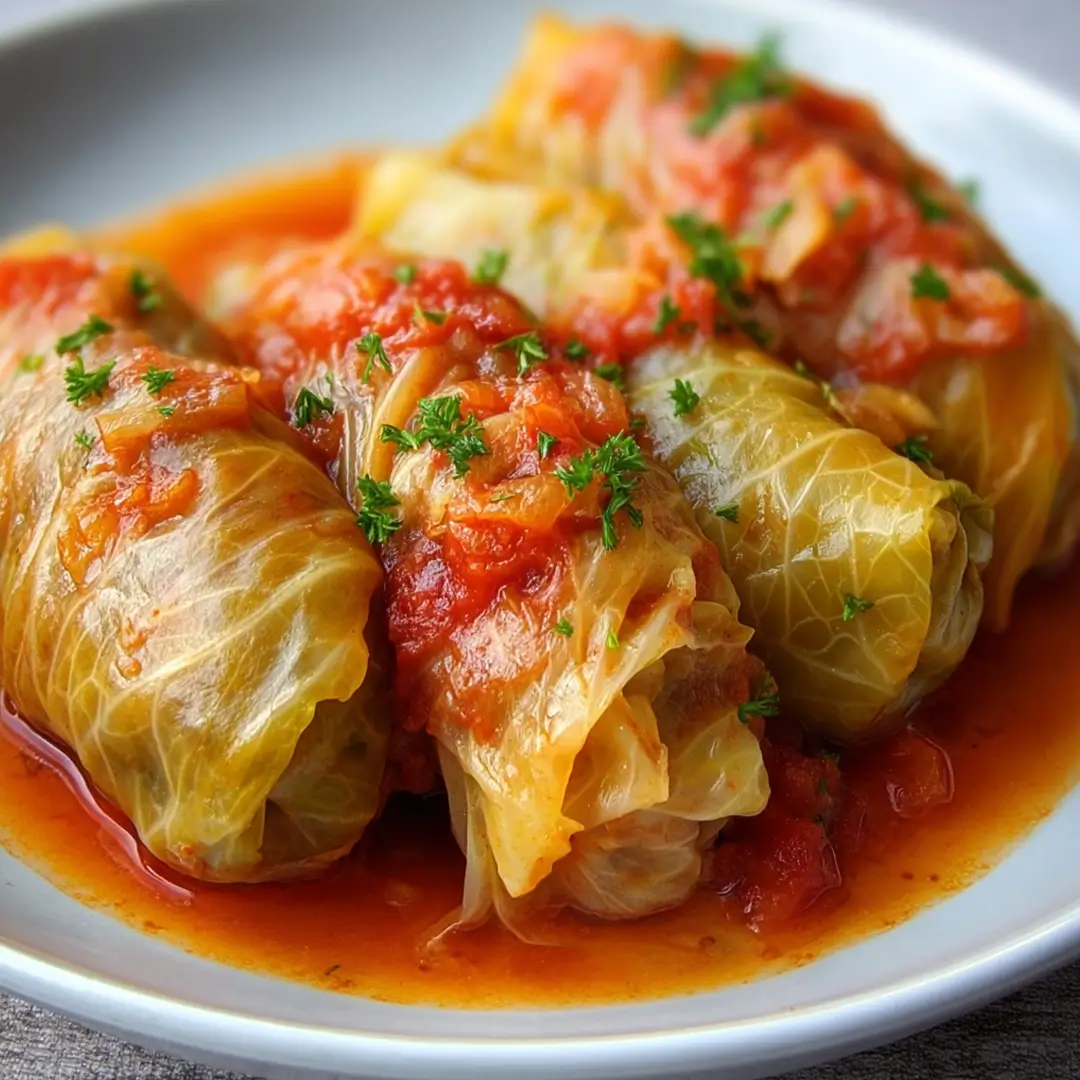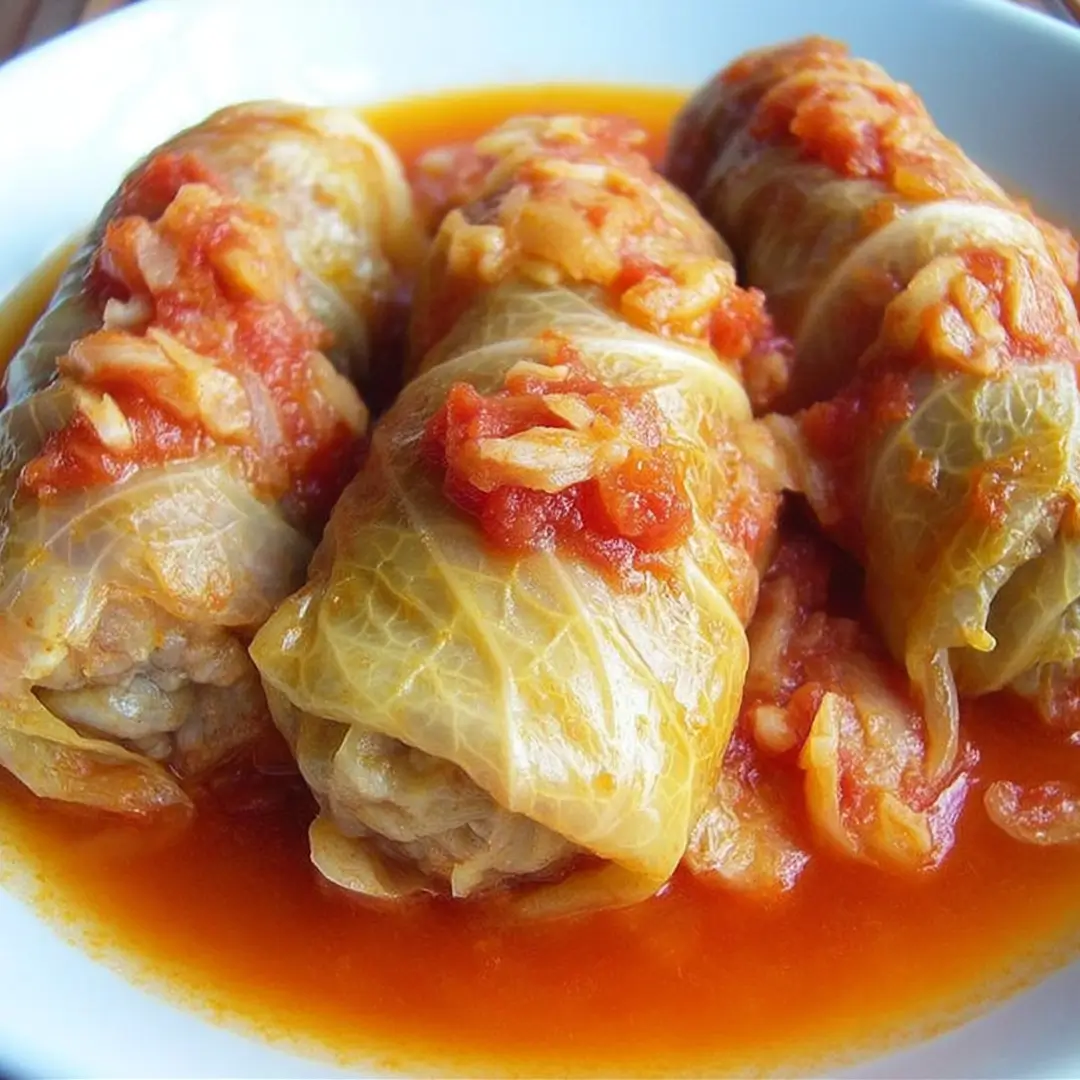Hungarian stuffed cabbage rolls are a staple of Central European home cooking. Known as töltött káposzta in Hungary, this dish features tender cabbage leaves wrapped around a seasoned mixture of ground meat and rice, then simmered slowly in a rich tomato sauce. It’s hearty, filling, and deeply rooted in tradition. Whether served at holidays or as an everyday meal, it delivers comforting flavors in every bite.
What I like most about this dish is its balance of simplicity and depth. The ingredients are straightforward, yet when combined and cooked properly, the result is full of flavor. The cabbage becomes silky, the filling stays moist, and the tomato sauce ties everything together. I also appreciate how it keeps well leftovers taste even better the next day. Over time, I’ve picked up a few tips that make the process easier and the end result more reliable, which I’ll share in this recipe.
Key Ingredients
Core Ingredients
The beauty of the Hungarian stuffed cabbage rolls recipe lies in how a handful of simple ingredients can come together to create something deeply comforting. The dish starts with green cabbage, which acts as the wrapper for the flavorful filling. Choose a large, firm head so you get plenty of wide leaves to work with.
The filling typically features ground beef lean but not too dry. You want some fat for flavor and moisture. For authenticity, opt for a beef-and-rice blend. The rice provides structure and absorbs the juices as everything cooks. I recommend parboiled white rice because it stays fluffy inside the roll without becoming mushy.
You’ll also need finely chopped onion and garlic, both of which are sautéed for a richer, deeper flavor. Hungarian sweet paprika is non-negotiable. It gives the rolls their signature warmth and slightly smoky taste.
Tomato sauce or crushed tomatoes make up the cooking base. They’re poured over and around the rolls to braise them slowly. Add salt, pepper, and bay leaves, and you’ve got the essence of this timeless dish.
Optional Additions
While traditionalists might stick to the basics, I’ve found a few extras can elevate the dish without compromising its roots.
-
A handful of sauerkraut layered between the cabbage rolls adds a delightful tang and complexity.
-
For more herbal notes, add fresh dill or parsley into the sauce before simmering.
-
A bit of lemon juice in the tomato base helps brighten the dish.
-
A sprinkle of caraway seeds introduces a subtle earthy spice, commonly used in Central European cooking.
How to Make the Hungarian Stuffed Cabbage Rolls

Step 1: Prepare the Cabbage Leaves
The key to rolling is soft, flexible cabbage leaves. There are two foolproof methods: boiling or freezing. I personally prefer boiling. Core the cabbage, then place it in a large pot of simmering water. Gently peel off the outer leaves as they soften usually about 3-4 minutes per layer. If you’re short on time, freezing the cabbage overnight works just as well. When thawed, the leaves become pliable with zero blanching needed.
Step 2: Make the Filling
While the cabbage cools, prep your filling. Combine ground beef, parboiled rice, sautéed onion and garlic, sweet paprika, salt, and pepper in a bowl. The filling should be moist but not too wet. If it feels dry, a spoonful of tomato sauce can help bind it all together.
Expert tip: Don’t skip the onion sauté. Raw onion can release moisture and stay crunchy, affecting the final texture.
Step 3: Roll and Layer
Take one cabbage leaf, place about 2 tablespoons of filling at the base, fold in the sides, then roll it up tightly. Avoid overstuffing. If you do, the rolls may burst open while cooking.
In a Dutch oven or deep pot, place a layer of sauerkraut or chopped cabbage, then nestle the rolls in tightly. Stack them in layers if needed.
Step 4: Cook Until Tender
Pour crushed tomatoes or tomato sauce over the rolls, just enough to submerge them. Add bay leaves, a little lemon juice, and bring to a simmer. Cover and cook gently for about 1.5 to 2 hours. For a richer flavor, let them rest overnight they taste even better the next day.
My Best Hungarian Stuffed Cabbage Rolls Tips
Use Cooked vs. Raw Rice?
One question I often hear is whether to use raw or cooked rice in the Hungarian stuffed cabbage rolls recipe. The short answer? Parboiled or partially cooked rice is your best bet. Using fully raw rice risks uneven texture, while overcooked rice can go mushy. I usually cook mine about halfway before mixing it into the filling. This ensures the rice finishes cooking as the rolls braise, absorbing the flavors without turning to paste.
Keep the Rolls Tight but Not Overstuffed
Stuffing cabbage leaves is a bit of an art form. It’s tempting to overfill each leaf, but this is where things can go wrong. Overstuffed rolls tend to burst open, especially when stacked. Instead, place a modest amount of filling just enough to allow room for the leaf to fold comfortably. Roll tightly, but not so firm that the leaf tears. It takes practice, but the results are worth it.
Let the Flavors Develop
If you can wait, these rolls get better after a day in the fridge. The tomato sauce thickens, the cabbage softens further, and the seasoning soaks into every layer. Whenever I’m cooking a big batch, I plan for leftovers. Reheating the next day often makes them taste richer, deeper, and more satisfying.
Storage and Freezing
This dish is incredibly freezer-friendly. Let the rolls cool fully, then store them in an airtight container with enough sauce to keep them moist. They’ll last up to three months. Reheat gently in a saucepan or oven with a splash of water or tomato juice to bring them back to life.
For more delicious dinner ideas, check out this comforting crock pot ground beef vegetable soup. It’s another cozy classic perfect for meal prep.
Variations of Hungarian Stuffed Cabbage Rolls
Vegetarian Version
Stuffed cabbage doesn’t have to include meat to be satisfying. A vegetarian version can be just as flavorful. I like using lentils or mushrooms as a base, mixing in cooked quinoa or brown rice for texture. Season heavily with smoked paprika, garlic, and onions to keep the savory depth. Adding finely chopped walnuts or sunflower seeds also mimics the heartiness of ground meat.
Spicy Version
For those who love a bit of heat, spice it up. Use hot Hungarian paprika, add red pepper flakes, or even stir a spoonful of harissa or chili paste into the tomato sauce. It gives the dish a warming kick without overwhelming the traditional flavors. Just balance the spice so it doesn’t outshine the cabbage or beef.
Grain Alternatives
Rice isn’t your only option. I’ve experimented with bulgur, couscous, and even farro with good results. Each brings its own texture and slightly nutty flavor. These grains also hold up well to long cooking, staying firm without going soggy. Just be sure to par-cook them before mixing into the filling.
Different Sauces
While tomato sauce is the classic, there’s room to get creative. Try a tomato-cream sauce for added richness, or infuse the sauce with fresh dill for a more herbaceous flavor. In some regions of Hungary, people even add a splash of sour cream at the end for a tangy finish.
Each of these tweaks brings a fresh twist to the traditional Hungarian stuffed cabbage rolls, while keeping the heart of the dish intact.
FAQs
What Country Does Stuffed Cabbage Come From?
Stuffed cabbage is popular across Central and Eastern Europe, but Hungary has its own special version known as töltött káposzta. While versions of this dish appear in Polish, Romanian, and Ukrainian cuisine, the Hungarian stuffed cabbage rolls recipe stands out for its use of sweet paprika, tomato-based sauces, and often a layer of sauerkraut for extra depth. It’s typically served during festive seasons like Christmas, but honestly, it’s satisfying year-round.
What Is the Best Way to Soften Cabbage for Cabbage Rolls?
There are two tried-and-true methods: blanching and freezing. I personally prefer blanching because it gives you control over the texture. Simply remove the core and place the whole head into simmering water. As the leaves soften, peel them off one by one. If you’re short on time, freeze the cabbage overnight, then thaw it. Freezing naturally breaks down the leaf fibers, making them pliable without boiling.
Why Do You Freeze Cabbage Before Making Cabbage Rolls?
Freezing is a clever shortcut. It mimics the effect of blanching by softening the cabbage leaves through cellular breakdown. When the cabbage thaws, the leaves become soft and easy to roll no hot water or peeling required. It’s a great option when prepping ahead or avoiding stovetop steps. Just remember to drain the cabbage well once thawed to prevent soggy rolls.
What Goes in Stuffed Cabbage?
The heart of the Hungarian stuffed cabbage rolls recipe is a flavorful blend of ground beef, rice, onion, garlic, and paprika. These are wrapped in softened cabbage leaves and simmered in a seasoned tomato sauce. Optional ingredients like sauerkraut, fresh herbs, and lemon juice add variation and brightness, but the base remains humble and hearty.
Print
hungarian stuffed cabbage rolls recipe
- Total Time: 2 hours 30 minutes
- Yield: 6–8 servings 1x
Description
Hungarian Stuffed Cabbage Rolls (Töltött Káposzta) are a classic, comforting dish where tender cabbage leaves are filled with seasoned pork and rice, then simmered in a tomato-paprika broth with layers of tangy sauerkraut. This traditional recipe delivers hearty, satisfying flavors and gets even better the next day, making it perfect for both special occasions and family dinners.
Ingredients
1 large head green cabbage (or 2 medium). You’ll need 12 large leaves
2 Tbsp vegetable oil
1 cup yellow onion, finely chopped
2 cloves garlic, minced
2 lbs ground beef
1 cup cooked long grain rice
4 tsp Hungarian paprika, divided
2 tsp kosher salt
1 tsp black pepper
2 large eggs, lightly beaten
2 cups water
1/4 cup tomato paste
1 lb refrigerated fresh sauerkraut, divided
Instructions
-
Soften the Cabbage Leaves
Core the cabbage and place it in a large pot of simmering water. Carefully remove 12 large leaves as they soften, about 3–4 minutes per layer. Set aside to cool and drain. Trim thick veins if needed for easier rolling. -
Sauté the Aromatics
In a skillet, heat the vegetable oil over medium heat. Add the chopped onion and cook for about 5 minutes until softened. Stir in the garlic and cook for 1 more minute. Remove from heat and let cool slightly. -
Make the Filling
In a large bowl, combine the ground beef, cooked rice, sautéed onion and garlic, 2 teaspoons of Hungarian paprika, salt, pepper, and beaten eggs. Mix until fully combined but not overworked. -
Assemble the Rolls
Place a cabbage leaf on a flat surface. Add about 1/3 cup of the filling near the base. Fold the sides inward, then roll up tightly from the bottom. Repeat with the remaining leaves and filling. -
Layer and Add Sauce
In a deep pot or Dutch oven, spread half of the sauerkraut on the bottom. Arrange the cabbage rolls seam-side down over the sauerkraut. In a separate bowl, whisk together water, tomato paste, and the remaining 2 teaspoons of paprika. Pour this mixture over the rolls and top with the remaining sauerkraut. -
Simmer Gently
Cover the pot with a lid. Bring to a gentle simmer, then reduce the heat and cook on low for 1.5 to 2 hours. The cabbage should be tender and the filling fully cooked. Let the rolls rest for 10–15 minutes before serving.
Notes
- Rest Overnight: This dish tastes even better the next day after the flavors meld perfect for meal prep or make-ahead dinners.
- Freezer Friendly: Cool completely, store in airtight containers, and freeze for up to 3 months. Reheat gently with a splash of broth or tomato juice.
- Cabbage Tip: If short on time, freeze the whole head of cabbage overnight instead of boiling. Thaw to soften the leaves easily.
- Prep Time: 30 minutes
- Cook Time: 2 hours
- Category: Lunch
- Method: Simmering
- Cuisine: Hungarian
Nutrition
- Serving Size: 1 stuffed cabbage roll
- Calories: 330
- Sugar: 5g
- Sodium: 640mg
- Fat: 18g
- Saturated Fat: 7g
- Unsaturated Fat: 11g
- Carbohydrates: 19g
- Fiber: 3g
- Protein: 23g
- Cholesterol: 90mg
Keywords: hungarian stuffed cabbage rolls, töltött káposzta, beef cabbage rolls, sauerkraut stuffed cabbage, traditional hungarian food, paprika cabbage rolls, tomato beef rolls, comfort food recipes



